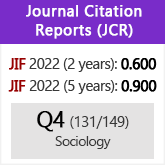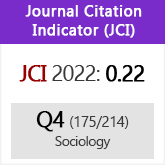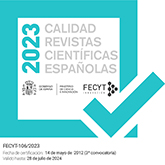Submissions
Submission Preparation Checklist
As part of the submission process, authors are required to check off their submission's compliance with all of the following items, and submissions may be returned to authors that do not adhere to these guidelines.- I've read Editorial CSIC's Good Practice Code and comply with all its guidelines.
- The Authorship, good publication practice and copyright transfer statement is filled and signed, and it'll be added to the submission.
- The article has not been previously published, and has not been sent to another journal for consideration.
- The submission is an original work and does not violate the copy and reproduction rights of other authored works. If necessary, the author has written permit for the reproduced work and a copy will also be submited.
- The person making the submission has been authorized by all the article authors to submit and act as their spokesperson in front of the journal during the review, editing and publishing processes.
-
Each of the authors has been identified including the following data:
- Given name (in full form) and family name(s).
- Email contact address.
- Country of professional activity.
- Institutional affiliation.
- Open Researcher and Contributor Identifier (ORCID).
- Role/roles according to the CRediT taxonomy. - I have consulted and applied the journal's Research data policy.
- The article is adapted to the Microsoft Word template provided by the journal.
- The text adheres to the length, format, references, citation of figures, tables and equations (if applicable), and bibliography requirements outlined in the journal guidelines.
- TWO versions of the article are sent, one in a Microsoft Word, LibreOffice, or compatible file, that will include any graphic element in the place considered most advisable. A second file, in PDF format, will include all the elements of the first one except those that allow the identification of the authors both in the text (name and affiliation, CRediT role/roles, self-citations, personal notes, etc.) and in the metadata of the file (check the "Properties" of the PDF in the "File" section). This second version will be the one used for the external evaluation, therefore, all the contents will be exactly the same in these two files, except for the modifications necessary to anonymize the PDF document.
Author Guidelines
Download HERE the Good Practice Code in PDF
Download HERE the Authorship Form in PDF
Submissions for publication in Revista Internacional de Sociología must strictly adhere to the rules contained in the following sections. Submissions that do not comply will be rejected.
Only original papers that have not been previously published and have not been submitted to other journals will be accepted.
Editorial policy
Revista Internacional de Sociología is a publication that accepts various types of research texts (articles, themes and current state of research) in sociology, in its different fields of specialisation, but also in political science, anthropology and social and moral philosophy, which contribute to the progress of the social sciences and to the knowledge of social reality.
RIS aims to achieve the highest possible quality in its publications, applying demanding scientific review criteria.
RIS is a bilingual publication that accepts papers in both Spanish and English.
RIS recommends the use of non-sexist and inclusive language in texts submitted for publication.
In research involving the participation of populations (whether children, young people or adults), the relevance of incorporating sex or gender as a variable of analysis and establishing whether this has had an influence on the results obtained will be considered. Thus, it is expected that the results will mention differences between sexes or due to gender relations or, on the contrary, the absence of differences.
In order to make the work of men and women visible, the list of references should cite the full names of the persons mentioned in the text, avoiding initials as far as possible.
Journal format
Revista Internacional de Sociología is an open access journal. Articles will be published online in HTML, XML and PDF and will be made available to readers, without restriction, immediately after online publication.
Types of contributions
Revista Internacional de Sociología publishes the following contributions:
1) Article
2) Topics
3) Debates
4) State of the Art Review
5) Tribute
1) Article
Articles are original texts that follow the academic structure accepted in scientific journals. They comprise a title, abstract and key words in Spanish and English, an outline of the work’s theoretical rationale and clear statement of aims, a description of bibliographical sources, methodology, results, and discussion thereof, final conclusion, and bibliography.
Articles should be minimum 7000 and maximum 10000 words long, including all sections and appendices. Articles that exceed this limit will not be accepted.
They must follow the presentation layout of the downloadable template.
All references listed in the bibliography must include the DOI.
The use of footnotes is discouraged, but if necessary, these should be used sparingly and always inserted at the end of the document as endnotes.
The sections of the document must not be numbered and must be in lower case bold type.
The Editorial Board may reject an article without previously sending it for external review in cases when the Board considers that the article does not conform to the guidelines, is not in line with the journal’s publishing profile, or does not meet the required publication standards.
Manuscripts which are successful at the pre-evaluation stage will be peer reviewed according to the double-blind review method. They will be presented for external review to at least two specialists in the given subject area.
Nevertheless, at the time of submission authors have the right to propose up to three specialists in the field of the submitted manuscript who may participate in the review process. The proposed specialists cannot be part of the same university department or research institute, they may not have published jointly with the author(s) in the last five years, nor participated with them in the same research project in the last ten years.
The anonymity of all authors and all those participating in the review process is guaranteed at all times.
The Editorial Board will study the reviews and decide whether to accept or reject the article, as well as in which volume and issue it should be published in case it has been accepted.
We will endeavour to notify authors whether their manuscript has been accepted or rejected within a maximum of six months from the moment that the author is informed of the submission of their manuscript for external review. By exception, the Editorial Board reserves the right to extend the above deadline to nine months, in which case all authors will be informed.
2) Topics
A Topic is a publication which focuses on empirical subjects and therefore has a more limited theoretical and analytical development.
These texts will extend to a minimum of 6000 and a maximum of 8000 words in total, including title, abstract, key words, tables, bibliography, and endnotes.
They must follow the presentation layout of the downloadable template.
All references listed in the bibliography must include the DOI.
The Editorial Board may reject a Topic without previously sending it for external evaluation in cases when it considers that the article does not conform to the guidelines, is not in line with the journal’s publishing profile, or does not meet the required publication standards.
Manuscripts which are successful at the pre-evaluation stage will be peer reviewed according to the double-blind review method. They will be sent for external review to at least two specialists in the given subject area.
Nevertheless, at the time of submission authors have the right to propose up to three specialists in the field of the submitted manuscript who may participate in the review process. The proposed specialists cannot be part of the same university department or research institute, they may not have published jointly with the author(s) in the last five years, nor participated with them in the same research project in the last ten years.
The anonymity of all authors and all those participating in the review process is guaranteed at all times.
The Editorial Board will study the reviews and decide whether to accept or reject the article, and in which volume and issue it should be published in case it has been accepted.
We will endeavour to notify authors whether their manuscript has been accepted or rejected within a maximum of six months from the moment that the author is informed of the submission of their manuscript for external review. By exception, the Editorial Board reserves the right to extend the above deadline to nine months, in which case all authors will be informed.
3) Debates
These texts present a discussion based on an article published in the same issue of the journal. The topics featured will be proposed by the Editorial Board. The length of these articles will be 3500 words maximum, including title, abstract, key words, tables, bibliography, and endnotes.
They should follow the presentation layout of the downloadable template.
All references listed in the bibliography must include the DOI.
The original manuscripts will be reviewed by at least two members of the Editorial Board and may also be subject to an external review. The Editorial Board will study the reviews and decide whether to accept or reject the article, and in which volume and issue it should be published if accepted. We will endeavour to notify authors whether their manuscript has been accepted or rejected within a maximum of three months.
4) State of the Art Review
These texts analyse a body of recent publications which are within the same subject area or are connected thematically and may therefore adequately represent the current state of research on a given topic. Proposals related to a single published work or monograph will not be accepted. The works analysed in this section must be duly justified by their scientific and academic significance. The texts must comprise title, abstract, and key words (in Spanish and English). They will be structured as follows: introduction, an outline of the work’s rationale and clear statement of aims, description of bibliographical sources and discussion thereof, a conclusion, and bibliography (differentiating the reference works which motivate the proposed analysis from the rest of the bibliographical sources).
Texts may not exceed the 5000-word limit.
They should follow the presentation layout of the downloadable template.
The original manuscripts will be reviewed by at least two members of the Editorial Board and may also be subject to an external review. The Editorial Board will study the reviews and decide whether to accept or reject the work, and in which volume and issue it should be published if accepted. We will endeavour to notify authors whether their manuscript has been accepted or rejected within a maximum of three months.
5) Tribute
A brief text which pays tribute to a person who has made a significant contribution to the research life of the Revista Internacional de Sociología. The Editorial Board will propose people as subjects for these texts.
Special Issues
Revista Internacional de Sociología also publishes special issues. These issues are subject to a process of public tender. The Editorial Board will decide annually whether to call a tender for the publication of a special issue. In case of an affirmative decision, the call of tender will be published in the RIS and notified via its communication channels.
The Editorial Board will select one successful proposal from all those received by the end of the first half of the year in question.
Proposed special issues will comprise at least six articles and no more than seven, as well as a short introduction where the current research in the field of the subject of the monograph is appraised. The articles may be in Spanish or English, but there must be only one language used throughout, that is to say that all articles included must be in the same language. At least five of the articles must receive a positive evaluation from the external review process and from the Editorial Board’s final decision in order for the initial proposal to be published as a Special issue of the RIS.
Proposals must be sent by email to ris@iesa.csic.es and must contain the following information:
1. Title of the Special issue.
2. Name, institutional affiliation, email address, ORCID, and a short biography of the editor(s) and author(s) invited to collaborate in the monograph.
3. A summary of the Special issue’s proposed subject.
4. A rationale of the proposal providing context and academic scope within the field of social sciences, highlighting in particular its relevance from a sociological perspective, as well as the contribution that will be made to the current state of research. The proposal must stand out as original and innovative, and the question to which it intends to contribute must be clearly stated.
5. Authors, titles, abstracts (250 words) and key words of the articles which form part of the Special issue. The direct link of every article’s abstract to the overall contribution of the monograph will be valued positively; each article must be explicitly related to the object of the monograph.
6. A dissemination plan for the monograph.
Procedure and responsibilities for invited editors
Any proposals received will be evaluated by the Editorial Board at the Revista Internacional de Sociología according to the following criteria: originality of proposal, contribution to the current state of the art and the specific research area, the experience of the invited editors in a particular area of investigation, the experience of the invited editors and authors in the publication of scientific journals, originality of contributions in the form of articles, clarity and precision of the proposed contributions, coherence between the articles and the Special issue as a whole, as well as the overall meeting of the RIS publication standards.
Once a proposal has been selected, the editors will be informed about the procedure to follow, as well as the changes or modifications, if any, that need to be made to the original. Invited editors commit to following the publishing guidelines of RIS.
All contributions to the Special issue will be evaluated following the normal procedure set out by RIS.
The Editorial Board may reject the publication of the monograph in cases when the submitted articles do not meet the deadlines or the quality criteria established by RIS.
Frequency of publication
Revista Internacional de Sociología publishes an annual volume comprised of four quarterly issues.
REVIEW POLICY
The submission of a manuscript to any section of the journal does not automatically imply its acceptance for publication.
All submissions are reviewed initially by members of the Editorial Board who will evaluate if the content is in line with the journal’s publishing standards, if the manuscript adheres to the criteria established for each section, and if the manuscript submission guidelines have been fulfilled.
Any article, part of a Special issue or not, that passes this initial evaluation will go through to a second round of peer review according to the double-blind review method. In case any revisions are required, suggestions will be made available to all those named as authors, so that they can carry out the required modifications.
The Editorial Board is solely responsible for taking the final decision about manuscript publication.
PREPARING YOUR PAPER
Papers should follow the submission format available in the downloadable template HERE.
RIS journal uses iThenticate software as a plagiarism detection tool.
Accepted articles will appear in the "Latest Issue" section as soon as the proofs are checked by the authors and RIS. No changes can be made to the article after it has been published online. The dates of receipt, acceptance and online publication will appear at the beginning of each article. The corresponding author will receive the PDF and is responsible for the final version of the published articles.
Submission format
Original papers should be submitted following the attached template in Microsoft Word format, Georgia font, 9 point font size, 1.5 line spacing.
Original articles should be sent in one file without any reference to the identity of the author(s) within the text, without acknowledgements or sources of funding.
The file with the anonymised text will be accompanied by another file containing a brief curriculum vitae (around 50-100 words) of the author(s), with full names and surnames, and their corresponding e-mail addresses, as well as acknowledgements and references to funding, if any. Likewise, authors may mention up to three possible reviewers when submitting their article. The proposed persons may not belong to the same university department or research institute, have published jointly in the last five years or have participated in the same research project in the last ten years.
a. Title. The title, in Spanish and English, should be explicit and clearly reflect the content of the paper.
b. Authorship. Full name(s) and surname(s) of those signing the paper; organisation or workplace; country and e-mail address(es).
IMPORTANT: it is compulsory to include the ORCID number next to the authorship affiliation. If you are not registered, you can register in ORCID, free of charge, through the website https://orcid.org/register.
Authorship contribution statement
This journal applies the CRediT taxonomy for identifying authorship contributions based on the assignment of
specific roles to research articles. For more information see "Submissions/Authorship identification". This information should be incorporated in the full version of the manuscript (Microsoft Word file, LibreOffice, or a compatible format), under an "Authorship contribution statement" heading, located just before the abstract, in the following format (see downloadable Microsoft Word template):
Authorship contribution statement
Name and Surname author 01: Conceptualization, Formal analysis, Funding acquisition, Investigation, Methodology, Writing – original draft, Writing – review & editing.
Name and Surname author 02: Conceptualization, Formal analysis, Investigation, Methodology, Writing – review & editing.
c. Abstract. Articles must include an abstract of a maximum of 150 words in both Spanish and English, stating the objectives, approach and conclusions of the work.
d. Key words. A maximum of 5 key words, in Spanish and English, not included in the title, should be included.
e. Drafting of the text and presentation. The text should be clear, concise and inclusive. Texts may be written in Spanish or English. Notes will be accepted, as long as they are the minimum necessary and placed at the end of the text.
f. Tables, figures and photographs. The number of tables, figures and photographs should be limited to those that are truly representative. They should be numbered consecutively as they appear in the text and each one should have an explanatory title at the top and a caption at the bottom, indicating the source. If they are not self-produced, the source must always be indicated.
Tables, figures, graphs and photographs should be included in the text in their corresponding place. They must also be sent in JPEG or TIFF format, in a single compressed ZIP or RAR file. Photographs and figures must have a minimum resolution of 300 pixels per inch for publication.
g. Formulas and/or mathematical expressions. They must be inserted in Word or LibreOffice itself, but under no circumstances must they be incorporated as images.
h. References. References follow the ASA format adapted for use in Spanish and the inclusion of the full first name instead of the initial.
References to publications appearing in the body of the text
References in the body of the text should follow the following format: if the authorship is individual (Schiebinger 1989: 89). When the work being cited is of multiple authorship, the following guidelines should be followed: in the case of two signatures, the surnames should be separated by "and" (Latour and Wolgart 1979); in the case of three, the surnames should be separated by a comma except for the last two only separated by "and" (Pycior, Slack and Abrir-Am 1996); and for four or more signatures, use et al. (Cruces et al., 2004).
If several citations are mentioned together, they should be arranged in chronological order and separated by semicolons (Dunlap 1991; Greene 2008; Endersby 2009). When references are by the same author, publication dates should be separated by semicolons (Creager 2002; 2007; 2013).
All references cited in the body of the text must be included in the References section and vice versa. They will always be included at the end of the work, alphabetised by the surname of the first author. When the reference is an article with a DOI (Digital Object Identifier), this must always be indicated at the end of the reference. To check whether or not a bibliographic reference has a DOI, it can be consulted at the following address (it can be searched individually or by blocks): http://www.crossref.org/SimpleTextQuery.
When a literal citation is included, the specific page should be included (Bourdieu 2000: 24) (Walby 2021: 24). If more than one work published in the same year by the same author is mentioned, the year is postponed by a lower case letter as an ordinal (Sen 1999a; 1999b). If you want to include the specific pages of the works published in the same year, this should be indicated as follows: (Sen 1999a: 55; 1999b: 376). If you want to cite two publications by the same author, but in different years (Barbarosa 1973; 1978).
If the name of the author already appears in the sentence, only the date of the work is included: "The republicanism of Sunstein (2006) and Pettit (2007) differs...".
When you want to cite two or three authors of a publication, all the names will appear: (Kelly, Colter and Lane 1980). If the publication has been written by more than three authors (Turner et al. 1987).
If you want to reference different authors in different years, start with the most recent work: (Confucius 1951; Gurdjieff 1950; Wanisaburo 1926).
When a corporate or institutional authorship is cited for the first time, the full name of the institution should be included (National Institute of Statistics 2009). In subsequent citations, the acronym may appear (INE 2009).
If two authors with the same surname are to be mentioned, the first initial of their first name should be indicated in order to differentiate between them (B. Ripley 1988; R. Ripley 1964).
In the case of a reprint that is very distant in time from the original publication, the latter can be specified in square brackets to make it easier for the reader to understand the chronology of the publications; a modern reprint of Marx's text can be cited as (Marx [1867] 1975), but this is not essential.
If chapters, indexes or tables are to be specified (Neuman 1994, table 3.3) or (Clawson 1998, ch.2).
Bibliography
The bibliography used - i.e. only that which is referred to in the text - should be double-spaced at the end of the article, arranged alphabetically by author's surname and first name. Surname and first name will be repeated in each entry if several works by the same author are cited.
If the author has produced several works in the same year, a lower case letter is placed after the year as an ordinal.
Depending on the type of publication, the following criteria are used:
Books or monographs published by an author: Surname, Full name. Year of publication. Title in italics. Place of publication: Publisher.
Published by two authors: Surname, full name, preposition (y/and), first name and surname of the second author. Year of publication. Title in italics. Place of publication: Publisher.
Editions of a book: The edition should be indicated when it is different from the first if it is a true edition, i.e. a revised and modified text and not a simple reprint of the material. Surname, full name, abbreviation of publisher ("comp." if in Spanish; "ed." if in English) or its plural ("comps."; "eds."). Year of publication. Title (italics). Place of publication: Publisher.
If the chapter of a book is mentioned: Surname, Full name of the author of the chapter. Year of publication. "Title of the book chapter in inverted commas". Page abbreviation (Pp.) first page-last page preposition (en /in) title of the collective work in italics. Edition. Place of publication: Publisher.
Article of a collective work: Surname, first name of the author of the chapter. Year of publication. "Title of the book chapter in inverted commas". The abbreviation of pages (Pp.) first page-last page the preposition (en /in) and the title of the volume in italics, vol. no., coordinated or compiled by/edited by Name and Surname(s) of the editor(s). Place of publication: Publisher.
Books without authorship: Title of the work in italics. Year. Edition. Place of publication: Publisher.
Articles in periodicals:
General rule: Surname(s), Full name. Year of publication. Title of the article in inverted commas. Name of the journal volume (number), initial page-final page, DOI.
If the author has published several papers in the same year, a lower case letter is placed after the year as an ordinal.
Magazine and newspaper articles: Surname(s), Full name. Year of publication. "Title of article in inverted commas. Name of the newspaper in italics, number of the newspaper, day and month. Query Day/Month/Year (Path).
Thesis or Dissertation:
General rule: Surname(s), Full name. Year of edition. "Title of the thesis or dissertation in inverted commas". Thesis, Department, University, Country. Consultation Day/Month/Year (Access route).
Papers or conferences
Text of an unpublished paper or conference: Surname(s), Full name. Year. "Title of the paper in inverted commas. Text presented at the meeting, conference, congress, Date of celebration, city, country. Consultation Day/Month/Year (Access route).
Text of a published paper or conference: Surname, Full name. Year. "Title of the paper in inverted commas. Pp. in/in the name of the book or proceedings, edited by. Place of publication: Publisher.
Electronic resources
Journal article in electronic format: Surname(s), Full name. Year of publication. "Title of article in inverted commas. Name of the journal in italics Journal number: start page of the article - end page. Day/Month/Year query (Access path).
Electronic books: Surname(s), full name. Year of publication. Title in italics. Place of publication: Publisher. Consultation Day/Month/Year (access route).
Webs: Name of the website. Year of publication of the website. "Title of the section of the website in inverted commas". Place of the website: Editors of the website. Query Day/Month/Year (Access path).
Encyclopaedias (online): Name of the encyclopaedia in italics. Year of publication. "Encyclopaedia section title." Name of the encyclopaedia in italics. Query Day/Month/Year (Path).
Encyclopaedia (cd-rom): Name of the encyclopaedia in italics. Year of publication. "Title of the encyclopaedia section". Name of the encyclopaedia in italics, version [CD-ROM]. Place of publication: Publisher.
Computer programs: Author of the program. Year. Name of computer program. Place of publication: Company or Publisher.
Statistical Abstract: Author. Year. "Title of the section of the statistical summary." The no. of the table in which the statistical summary appears together with the preposition (en/in) and the title of the statistical summary, edition (if it is the first one it is not cited). Place of publication: Publisher.
To cite electronic references and Internet materials, consult the ASA guidelines available at: https://www.asanet.org/sites/default/files/savvy/documents/teaching/pdfs/Quick_Tips_for_ASA_Style.pdf.
All these references must bear the date of revision, when the content may change, and the date of consultation. Always add the link in http:// format and check that it works correctly.
Supplementary Files Preparation
Before you begin the submission, you should have the following files, in addition to the two versions of the article text (original and anonymised):
- Copyright Transfer Statement
- Compressed file with article images and graphics
- Reproduction contracts
These complementary files will be uploaded as different article components.
PROOFS AND COPIES FOR THE AUTHORS
Proofs will be sent to authors as PDF files for review and return within three days. No material corrections will be allowed on proofs.
Once final publication is made, the main author will be notified.
SUBMISSION INSTRUCTIONS
Below you will find instructions for the following procedures:
- How to register at Revista Internacional de Sociología
- How to send an original manuscript to Revista Internacional de Sociología
- How to check a revision report and submit a revised version of a manuscript
How to register at Revista Internacional de Sociología
1.- On the journal's website, click on the link "Register":
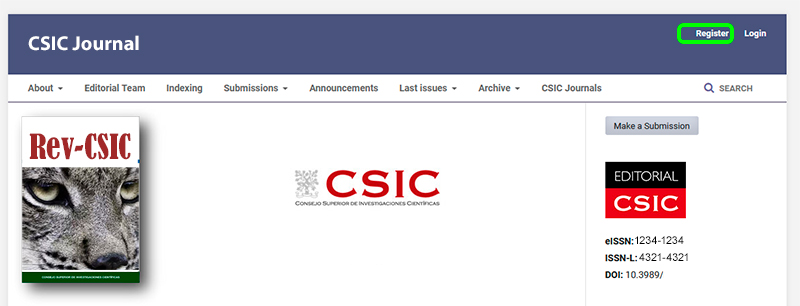
2.- On the registration page you will have to fill in all the fields (the "Family name" field is optional, although highly recommended) using lower case only for your email, username and password. After reading the Privacy Statement you will need to consent to the collection and storage of your data and complete the Captcha. Receiving notifications of new publications and notices is optional.
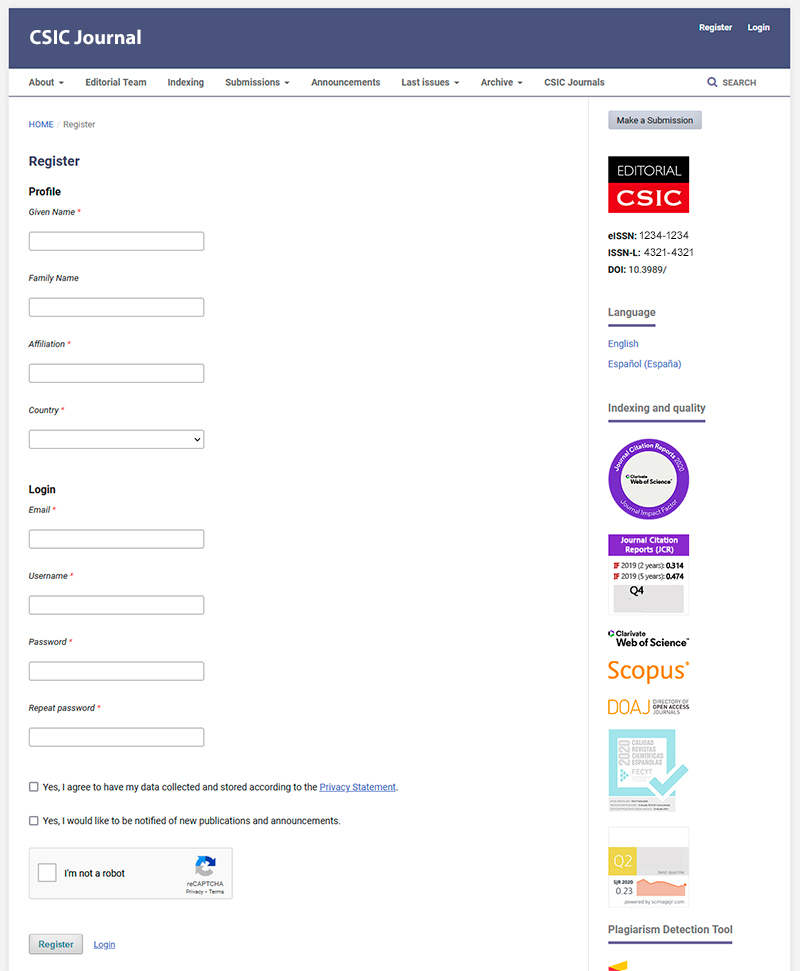
3.- You will receive a message with a link to activate your account at the provided email address. Once activated, you will be able to log in to your account with the credentials you created.
How to send an original manuscript to Revista Internacional de Sociología
1.- On the magazine's website, log in by clicking on "Login":
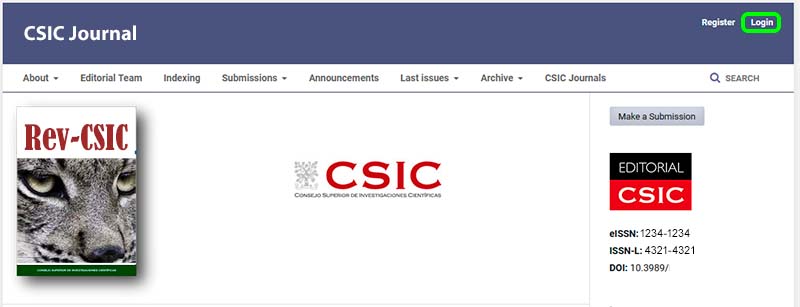
2.- Enter your username and password. Once you return to the magazine's homepage, click on the "Make a Submission" button:
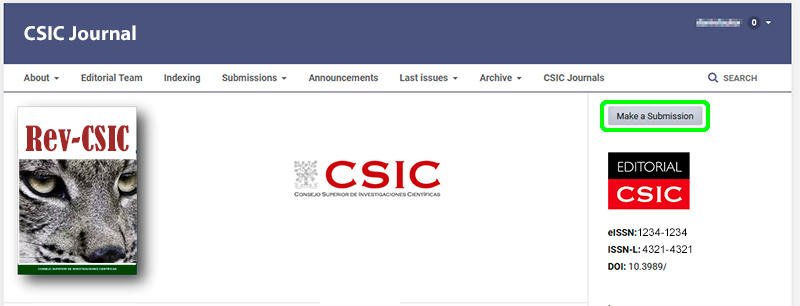
Before submitting, please review the "Submission Preparation Checklist" and read the "Author Guidelines", the "Copyright Notice" and the "Privacy Statement". When you have all the required documents ready, click on the link "Make a new submission".
In subsequent logins, you will be taken to your user dashboard. There press the ‘New Submission’ button to submit a new article. You will be shown any articles received and in process under the ‘My Queue’ tab):

3.- As you will see on the new submissions page, submitting a manuscript is a four-stage process, in addition to a final section with information on follow-up:
3.1.- "1. Start"
At this stage you must select the language in which the article is written and the section of the journal in which you think it would fit, you must indicate that you have prepared all the items on the "Submission requirements" list and, optionally, you may send comments to the editor. You must comply with the terms of the Copyright Statement and the collection and storage of your data as the author of the article in accordance with the Privacy Statement of the Consejo Superior de Investigaciones Científicas (CSIC).
Then press the "Save and continue" button.
3.2.- "2. Upload submission"
In this phase, the files that make up the article and its additional documentation will be uploaded to the management module.
There are three parts to upload each file. In the first one, we will select which component of the article we are going to contribute and we will upload the corresponding file. Once uploaded, click on the "Continue" button. In the second part we will see the file metadata, with the possibility to edit them, but we will click "Continue" without making this edition.
In the third part, select "Add Another File", going back to "1. Upload file" and, without modifying the default option "This is not a revision of an existing file", select the new "Article Component" identifying what it is and uploading the file. Click "Continue" until you reach, once again, step "3. Confirm". This process must be repeated until all the files have been sent, and only when all the material has been uploaded should the "Complete" button be selected.
If after "Completing" the submission we realise that we have forgotten to upload a file, we can do so by selecting the "Upload File" button located in the upper right-hand corner of the "2. Upload Submission" tab:

Once all the submission files have been uploaded, we will press the "Save and continue" button.
3.3.- "3. Enter Metadata"
In this phase the author will enter the metadata of the article according to the journal guidelines. These are:
- Title in Spanish and English. If the article is written in another language, it will be introduced first this language and then in English.
- Summary or abstract in the same languages as the previous item.
- List of contributors. Although it was not necessary when registering as a journal user, in this section it is compulsory for authors to have their ORCID identifier and affiliation correctly indicated. If necessary, the information of additional authors will be added using the link "Add contributor":

- Keywords. The article keywords will be inserted in both languages. The entire list cannot be copied, must be entered one term at a time pressing "Enter" after each one.
- Funding data. The entities that have supported the research published in the article must be indicated. After selecting "Add funder", the name of the funder should be inserted again, which will trigger an internal search that will return the institution standardised name and DOI. If the institution does not have a DOI, it will not be able to register in this field. After entering the grant numbers, click on "Save".
To finish this phase of entering metadata, click on the "Save and continue" button.
3.4.- "4. Confirmation" y "5. Next steps"
In this last phase we will confirm the submission metadata recording linked to the uploaded files. Before clicking on the "Finish Submission" button, we can go back to the previous phases and review the information and files provided to check that they are all correct.
Once we click on the "Finish Submission" button, the article will be sent to the journal and its staff will contact you to continue with the process, as indicated in the "5. Next Steps" section.
How to check a revision report and submit a revised version of a manuscript
Once your submission has been reviewed, the journal's staff will send you a review report. Once received, you must log in to the journal and, in the "Submissions" section of your dashboard, you will be able to check that your submission is in the Review phase and, if the editorial staff has requested, whether it is necessary to make any modifications or revisions to the manuscript:

By clicking on the title of your submission, you will be taken to the workflow of your submission and you will be able to check the information related to the its review. You will find the notifications that the editorial staff has sent you, the attachments that the reviewers may have attached and, if requested, the possibility to provide a new version of the manuscript with the requested modifications by clicking on the "Upload file" button:
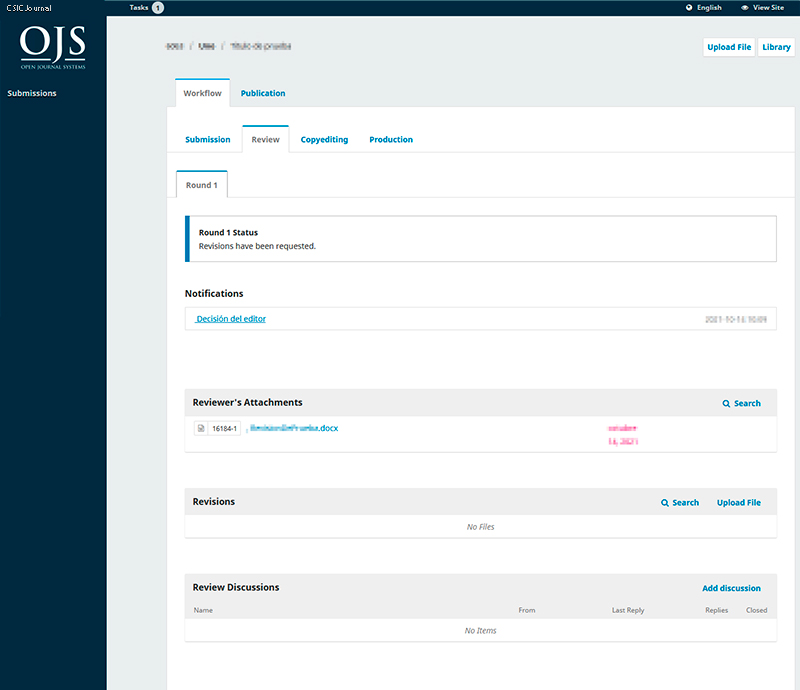
Research data policy
We recommend authors depositing data obtained from the research developed for the preparation of their article in repositories of recognized prestige, specific to the discipline or of a generalist nature. In any case, it must be a FAIR repository (Findable, Accessible, Interoperable, Reusable), preferably in open access.
There are several repositories destined to conserve and disseminate concrete data such as results of surveys, observations, interviews, simulations, automatically collected data, samples, models ... If necessary, authors can consult the Registry of Research Data Repositories re3data taking into account that each repository has its own deposit rules.
Those CSIC authors who would like to deposit their datasets in Digital.CSIC may do so by following these guidelines. They can use the Servicio de Archivo Delegado made available by the Technical Office of DIGITAL.CSIC and the Red de Bibliotecas CSIC.
DIGITAL.CSIC generates DOIs for datasets and associated software and is certified as data repository in re3data and Repository Finder. More information at Política de datos en Digital.CSIC.
If the author has deposited datasets in a repository, he should mention it in the article providing a brief description of the type of data deposited, the name and URL of the repository, the identification code and the data of the license for use and distribution. This information must be included at the end of the article, immediately before the bibliographic listing, under the heading "Data availability".
Download HERE the Good Practice Code in PDF
Download HERE the Authorship Form in PDF
Copyright Notice
© CSIC. Manuscripts published in both the printed and online versions of this Journal are the property of Consejo Superior de Investigaciones Científicas, and quoting this source is a requirement for any partial or full reproduction.All contents of this electronic edition, except where otherwise noted, are distributed under a “Creative Commons Attribution 4.0 International” (CC BY 4.0) License. You may read here the basic information and the legal text of the license. The indication of the CC BY 4.0 License must be expressly stated in this way when necessary.
Self-archiving in repositories, personal webpages or similar, of any version other than the published by the Editor, is not allowed.
Privacy Statement
The Spanish National Research Council (CSIC) has a record of data processing activities. Data collected through this form will be incorporated and processed in the “Gestión de las actividades de producción y distribución de las publicaciones del CSIC” treatment activity of Editorial CSIC, in order to manage the requested service. It is the responsibility of Editorial CSIC to manage this record. If you wish to exercise your rights, please contact us through the contact address Vitruvio, 8, 28006 Madrid, Spain, e-mail address publ@csic.es. Data processing is legitimized by the consent of the affected. The data may not be transferred to third parties except in the cases provided for in current regulations on the protection of personal data. You have the right to file a claim with the Spanish Data Protection Agency. You have the right to withdraw your consent. In the event that you wish -or want to exercise the rights of access, deletion, rectification, limitation or portability- you can do so through the following form. You can also contact the CSIC Officer for Data Protection via email: delegadoprotecciondatos@csic.es


